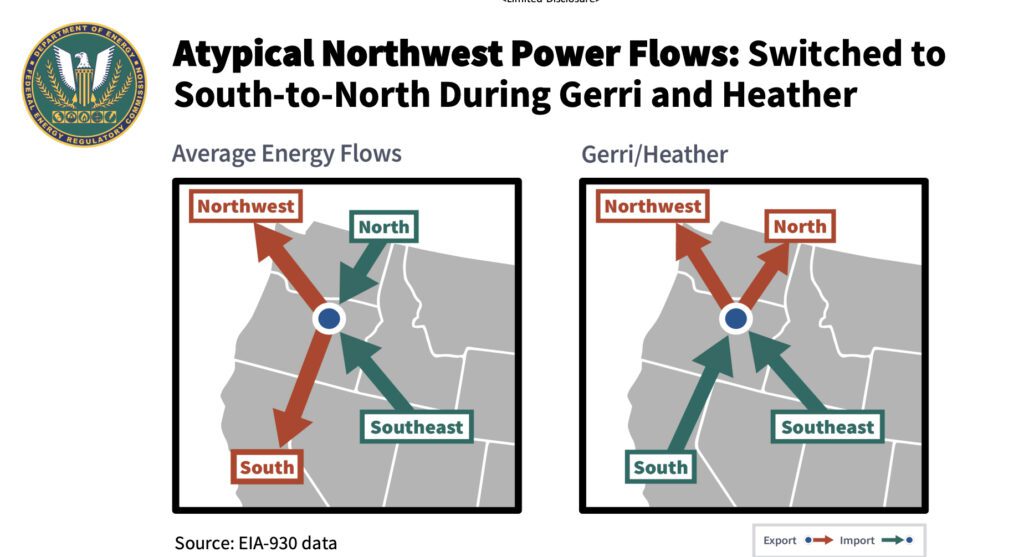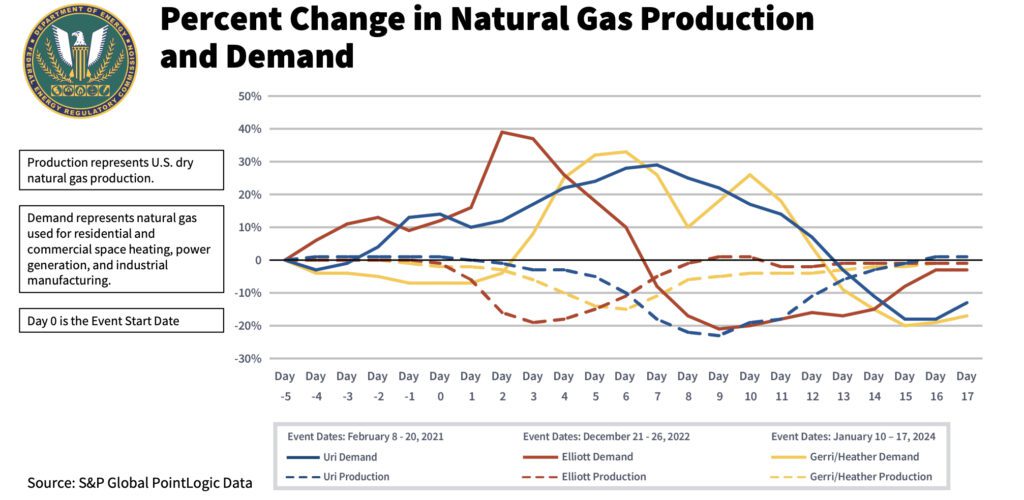FERC: Improved Preparations Mitigated January Winter Storms, Resulting in No Load Shed
Reliability measures implemented after Winter Storm Uri and Elliott were largely effective at averting distress on the power and natural gas systems during two severe arctic storms that swept across North America in quick succession in January, staff from the Federal Energy Regulatory Commission (FERC) and the North American Reliability Corp. (NERC) have reported.
During Winter Storms Gerri and Heather, which swept across North America from Jan. 10 to Jan. 17, 2024, the electric and natural gas industries “largely operated without major incident, though some entities did experience challenges,” FERC Attorney Adviser Chanel Chasanov told commissioners on April 25.
The assessment represents findings by FERC, NERC, and regional entities, which jointly reviewed electric and natural gas system performance during the storms. The review focused on key areas: weather conditions, natural gas performance, electric system planning and operations, and generator performance, Chasanov said.
A Huge Achievement Given Past Storms: Zero Load Shed
The joint review underscores that “there was zero system operator initiated load shed during Gerri and Heather,” Chasanov said. As significantly, “the natural gas and electric industries improved communication and coordination ahead of these arctic storms. Electric generator performance improved, which was attributed to improved preparedness, proactive commitments, and the use of alternate fuel supplies,” she said.
The performance of the natural gas and electric systems during the two storms illustrated the benefits of prior recommendations issued in joint FERC-NERC-Regional Entity reports, she noted. In general, that points to an optimistic outcome compared to Winter Storm Uri in February 2021 and Winter Storm Elliott in December 2022.
Winter Storm Uri prompted one of the worst blackouts in recent decades, triggering the loss of 68.1 GW of generation in the Electric Reliability Council of Texas (ERCOT), Southwest Power Pool (SPP), and the Midcontinent Independent System Operator (MISO). Winter Storm Uri led to the largest system operator initiated load shed event across North America, with over 23,000 MW of firm load shed.
Incremental unplanned generation outages triggered during Winter Storm Elliott spiked to 90.5 GW—representing 13% of the U.S. portion of anticipated resources in the Eastern Interconnection—and led to firm load shed of more than 5,400 MW. Concern about crippling extreme cold weather has mounted since the two storms. NERC has noted that Winter Storm Elliott was the U.S.’s fifth reliability-roiling winter storm in the past 11 years.
The successive nature of Winter Storms Gerri and Heather had posed a key concern, with the Pacific Northwest bearing the brunt of the storms. The cold-weather event notably set all-time record temperature lows, particularly in the Western portions of Oregon and Washington—where winters are typically mild.
However, “overall, Gerri and Heather had less freezing precipitation compared to Uri and Elliott and Gerri and Heather did not result in the uncharacteristic and extreme rapid decline in temperatures seen during Winter Storm Elliott,” Chasanov noted. “Another notable difference was that most entities generally did not encounter widespread freezing precipitation. As a result, entities did not experience the extent of icing on wind turbine blades that limits energy production from wind generators, as was seen during Winter Storm Uri,” she said.
Better Grid Operator Coordination
According to the assessment, the triumph was largely achieved through enhanced communication, coordinated efforts, and improved preparation, including proactive generator commitments and stable fuel supply methods, underscoring the ongoing necessity of implementing recommendations from previous reports
Matt Lewis, NERC manager of Event Analysis, noted that during the storms grid operators and balancing authorities held daily conference calls beginning seven days before the event and continued throughout. “These entities noted that this practice provided a higher level of situational awareness than they experienced during Uri and Elliott, and improved their ability to make more informed reliability decisions,” he said. Lewis also noted that some grid operators reported improvements to forecasting, for example, through multiple data inputs (such as temperature forecasts) in their load forecasting models and more robust wind forecasting.
In addition, he highlighted “significant amounts” of energy transfers, which helped grid entities navigate operational challenges. “Gerri and Heather continue to expose planning and operating challenges and highlight the importance of energy transfer capabilities, such as those being examined by the NERC Interregional Transfer Capability Study,” he said.

Fewer Generation Derates and Outages
Compared to Winter Storms Uri and Elliott, meanwhile, Gerri and Heather presented fewer generation derates and outages. “Some grid operators attributed this improvement to better estimating the operating limitations of generators and incorporating those risks into their operating plans (that is, not dispatching generators less likely to be able to perform),” noted Kiel Lyons, NERC senior manager of Compliance Assurance.
“Other grid operators stated that the use of on-site alternate fuel by generator owners and generator operators was helpful to avoid derates and outages when gas curtailments occurred.” In addition, some grid operators both procured more reserves and committed more generators to offset and account for unplanned generator outages, he said.
The extreme weather also suggest generators are benefitting from self-developed cold weather checklists, which help them review the status of their freeze protection measures, fuel availability, and other supplies, he suggested. While quantitative data about generator outages from Gerri and Heather is still not available, Lyons said some generators still suffered cold weather-related outages. Common reasons include plant equipment freezing, mechanical issues, a lack of fuel availability, and “other unknown issues,” which are still being analyzed, he said.
However, generators generally reported progress, Lyons suggested. “One grid operator stated that since Winter Storm Uri, a significantly higher percentage of its generators can operate below-freezing temperatures,” he said. And, after Winter Storm Elliott, “one entity simulated a mock winter peak event as a stress test to ensure it could meet a record demand day. A different grid operator heavily invested in winterization measures to enhance reliability.”
FERC’s presentation also suggests that gas generator stability showed improvements owing to non-ratable fuel supply methods, presumably through line pack, which allows gas received in one area of the pipeline to be delivered simultaneously elsewhere on the system.
Natural Gas System Entities Were Prepared
FERC staffer Robert Clark noted that while Winter Storms Gerri and Heather triggered a rise in natural gas demand coupled with a nearly simultaneous plummet in natural gas production, reliability concerns were limited and gas prices remained relatively moderate compared to previous arctic storms.
“Natural gas entities described many important steps taken to prepare for Gerri and Heather,” Clark noted. “Natural gas entities communicated current system conditions directly to the public through appeals for conservation and to shippers and relevant RTOs and ISOs via Electronic Bulletin Board operational notices.” In addition, pipeline operators took proactive measures by increasing pipeline pressures through storing more gas in pipelines (“line pack”).

However, even with heightened preparation, the gas system suffered a handful of debacles. One pipeline experienced underperformance at receipt points in the Upper Midwest, leading to a force majeure that reduced deliveries to a regional pipeline. The regional pipeline countered the shortfall by using Permian natural gas supply flowing from the South and and high-inventory natural gas storage. In a separate event, a communications equipment failure at a critical natural gas storage facility used to meak peak natural gas system loads was swiftly repaired.
Reliability Gains Are Notable But More Work Remains
The event validated the recommendations and lessons learned from Winter Storms Uri and Elliott, as well as from FERC and NERC’s December 2023 Blackstart Availability Study, which urged the natural gas and electric sectors to collaborate more strongly in planning efforts during extreme cold weather conditions, Clark said.
FERC staff noted that their Uri and Elliott inquiry reports make 39 recommendations in total. In addition, FERC and NERC at the meeting last week said they will work together to establish a “web-based public dashboard” to periodically provide status updates regarding responses to the recommendations made in the Uri and Elliott inquiry reports.”
Much has been achieved, but work still remains, the entities suggested. “Of the 39 total recommendations, progress has been made on two-thirds of them. This progress includes completing the development of the generator cold weather reliability standards initially recommended by the Uri Report.”
Of the remaining one-third of recommendations that still need attention, “most require more work to be done to improve natural gas cold weather preparedness and improvements to gas-electric coordination to reliably support the bulk-electric system,” they added.
—Sonal Patel is a POWER senior editor (@sonalcpatel, @POWERmagazine).